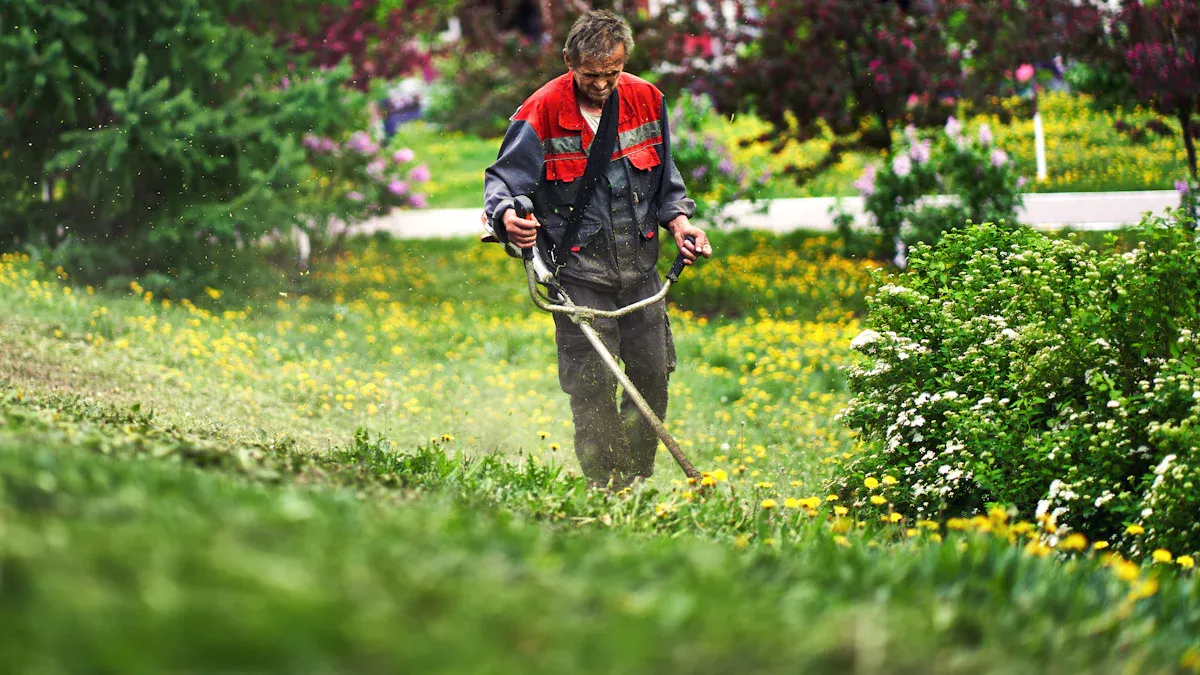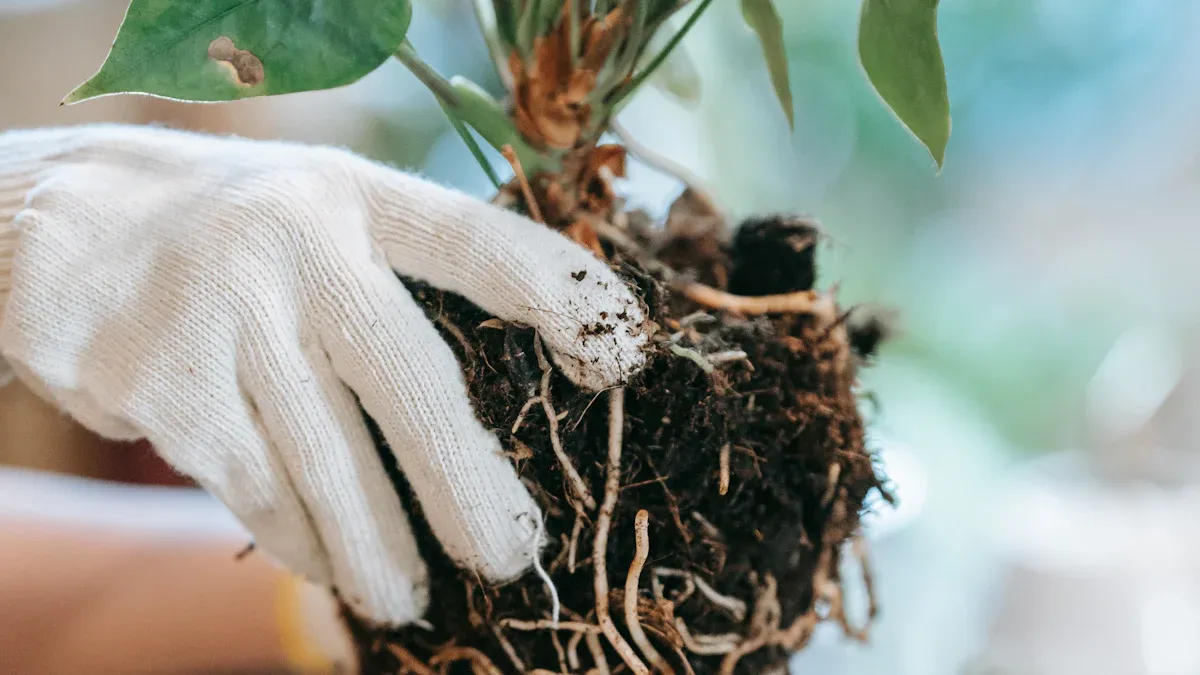
Preventing foundation damage from plant overgrowth is crucial for maintaining your home’s structural integrity. Ignoring this issue can lead to significant repair costs, such as:
Minor crack repairs: $500 to $1,000
Larger-scale repairs: $5,000 to $10,000
Common mistakes, like planting too close to the foundation or using excessive mulch, can worsen the problem. By taking proactive measures in your landscaping around your home, you can effectively prevent foundation plant overgrowth and protect your investment.
Key Takeaways
Choose plants with non-invasive roots to protect your foundation. This reduces the risk of roots causing damage.
Maintain a safe distance between plants and your foundation. Small trees should be at least 8 to 10 feet away, while larger trees need more space.
Regularly inspect your landscaping for signs of foundation issues. Look for cracks, uneven floors, and sticking doors to catch problems early.
Soil Types

Understanding soil types is essential for preventing foundation damage from plant overgrowth. Different soil compositions affect how roots grow and interact with your home’s foundation.
Identifying Soil Composition
To assess your soil, you can use various methods. Here are two common approaches:
Method | Description |
|---|---|
Laboratory Testing | This involves tests like Atterberg limits and particle size analysis to evaluate soil properties. |
In-situ Testing | This includes methods such as the Standard Penetration Test (SPT) to gather data on soil density. |
You should also consider the characteristics of your soil. For example, clay soils can expand when wet and contract when dry. This cycle can create pressure against your foundation, leading to cracks and settling.
Choosing Non-Aggressive Roots
When selecting plants, opt for species with non-invasive roots. These roots grow in a controlled manner, reducing risks to your home. Here are some tips for choosing the right plants:
Select trees with small, non-invasive root systems to avoid damage to nearby structures.
Non-invasive roots are less likely to disrupt sidewalks, sewers, or foundations.
Consider small-stature trees that do not grow along waterways.
By understanding your soil and choosing the right plants, you can significantly reduce the risk of foundation damage caused by aggressive roots.
Foundation-Safe Plants
Choosing the right plants is essential for protecting your foundation. Foundation-safe plants have specific characteristics that make them less likely to cause damage.
Characteristics of Safe Plants
Foundation-safe plants typically share several key traits:
Non-invasive roots: These plants have root systems that grow downward rather than spreading out. This minimizes the risk of roots pushing against your foundation.
Shallow root systems: Many safe plants have roots that do not penetrate deeply into the soil. This characteristic helps prevent disruption to the foundation.
Low maintenance: Foundation-safe plants often require less care, making them ideal for busy homeowners.
By selecting plants with these characteristics, you can significantly reduce the chances of foundation damage.
Recommended Plant Species
Here are some recommended plant species that are safe for planting near foundations:
Trees
Pine trees: Their roots extend straight down, minimizing impact on foundations.
Japanese maple: Known for its beautiful foliage, it has non-invasive roots, making it popular for patios and curbsides.
Flowering dogwood: This tree offers attractive flowers without risking foundation damage.
American holly: A low-maintenance evergreen with minimal soil impact.
Amur maple: Features a small root system, ideal for providing low-height shade.
Trident maple: A slow-growing option suitable for planting near patios.
Chinese pistache: Grows moderately and is often used as a street tree.
Southern sugar maple: Spreads less and showcases beautiful fall colors.
Shrubs and Ground Covers
Boxwoods: Evergreen and hardy, they are easy to shape and maintain.
Hydrangeas: These colorful blooms require low maintenance and add beauty to your landscape.
Juniper shrubs: Drought-tolerant and fragrant, they thrive in various conditions.
Ornamental grasses: Varieties like ruby grass and blue gramma are shorter, while feather reed grass can grow taller.
Herbs: Lavender, thyme, sage, and rosemary are fragrant and sun-tolerant.
Hostas and ferns: Great for shaded areas, they add lush greenery.
Ground cover plants: Options like candytuft, sedum, stonecrop, and creeping phlox provide seasonal color without invasive roots.
By being strategic with trees and shrubs, you can create a beautiful landscape that also protects your foundation.
Foundation-safe plants not only enhance your home’s curb appeal but also contribute to a healthier ecosystem. They support local wildlife and help maintain biodiversity. Choosing native plants can attract pollinators and provide habitats for various species.
Effective Landscaping Practices

Effective landscaping practices play a vital role in protecting your foundation. By implementing proper plant placement and ensuring water flows away from the house, you can significantly reduce the risk of foundation damage.
Proper Plant Placement
When you plant near your home, consider the distance between plants and your foundation. Research shows that the distance between trees and sidewalks affects root intrusion risk. For example, roots tend to cause less damage when trees are planted more than 3 meters away from structures. You should follow these guidelines for proper plant placement:
Small Trees: Plant small trees (25 feet tall or less) at least 8 to 10 feet away from your foundation.
Medium Trees: For medium trees (up to 40 feet tall), maintain a distance of 15 feet.
Large Trees: Large trees (greater than 40 feet tall) should be at least 20 feet away.
Type of Plant | Minimum Distance from Wall |
|---|---|
Small Trees (25 feet tall or less) | 8 to 10 feet |
Medium Trees (up to 40 feet tall) | 15 feet |
Large Trees (greater than 40 feet tall) | 20 feet |
Additionally, plant bushes at least 5 feet away from your home. This distance helps avoid root interference with your foundation. Proper grading of flower beds also helps. Ensure that they slope away from the foundation to direct water away and prevent damage.
Ensuring Water Flows Away from the House
Water management is crucial for protecting your foundation. Excess moisture can lead to soil expansion and contraction, which exerts pressure on your foundation. To ensure water flows away from the house, consider these effective techniques:
Regrading: Create gentle slopes in your lawn or garden beds to direct water away from your home.
Drainage Systems: Install dry creek beds or French drains to redirect water before it reaches your foundation.
Gutters Maintenance: Keep gutters and downspouts clear to direct rainwater away from your home, preventing pooling around the foundation.
Native Shrubs: Plant native shrubs to hold soil in place and prevent erosion that could expose the foundation to water damage.
Mulch: Use a thick layer of organic mulch to improve drainage, but avoid piling it against the foundation.
Rain Barrels: Install rain barrels to collect rainwater from gutters, reducing the amount flowing toward the foundation.
Hardscaping: Incorporate stone, brick, or concrete elements to redirect water flow away from the home.
Sealing Foundation Cracks: Regularly inspect and seal any cracks in the foundation to prevent water infiltration during heavy rains.
By following these landscaping practices, you can effectively protect your foundation from potential damage caused by plant overgrowth and excess moisture.
Regular Maintenance Checks
Regular maintenance checks are essential for preventing foundation damage. You should inspect your property periodically to catch any potential issues early. Seasonal changes can affect your foundation, so understanding how to conduct inspections is crucial.
Seasonal Inspections
Conducting seasonal inspections helps you identify early signs of foundation problems. Look for these common indicators during your checks:
Cracks in Walls and Ceilings: These may indicate foundation movement, especially if they widen over time.
Uneven or Sagging Floors: This suggests uneven settling of the foundation.
Doors and Windows Sticking or Misaligned: Shifting foundations can affect frame alignment, causing these issues.
Gaps Between Walls and Ceilings or Floors: These gaps are signs of structural shifts that require repair.
Exterior Brick or Masonry Cracks: Such cracks can indicate potential foundation issues that need prompt attention.
Seasonal changes can also impact the likelihood of foundation damage. The table below outlines how different seasons affect soil and foundation stability:
Season | Effect on Soil | Impact on Foundation |
|---|---|---|
Hot Summers | Soil shrinks due to moisture loss | Can cause foundation settling and uneven sinking |
Heavy Rains | Soil expands from saturation | Increases pressure on foundation, leading to potential cracking |
Winter Conditions | Soil expands due to freezing | Can cause frost heave, lifting the foundation |
Spring Thaw | Soil becomes unstable | Can lead to significant foundation movement |
By inspecting the perimeter of your home regularly, you can catch these signs early and address them before they escalate into costly repairs.
Pruning and Trimming Techniques
Proper pruning and trimming techniques can help control plant growth near your foundation. Here are some effective methods:
Reduction Pruning: This technique manages the size of trees and shrubs to prevent interference with structures. Trim long, unbranched stems just above a healthy bud to encourage lower side branches.
Thinning: For mature shrubs, remove old, weak, or crossing branches. This allows more sunlight to reach the interior, stimulating growth.
These techniques not only help maintain the aesthetic of your landscape but also reduce the risk of foundation damage. By providing clearance from structures, you ensure that trees do not grow too close to your home, which can cause damage over time.
Regular maintenance checks, including seasonal inspections and effective pruning, are vital steps in protecting your foundation. By staying proactive, you can prevent foundation problems and maintain the integrity of your home.
In summary, you can prevent foundation damage by implementing key strategies. Ensure water flows away from your home, plant trees at a safe distance, and maintain clear drainage systems. Regularly inspect your landscaping choices to protect your investment and enhance your home’s curb appeal. 🌳🏡
FAQ
What types of plants should I avoid near my foundation?
Avoid plants with aggressive root systems, such as willows and poplars. These can damage your foundation over time.
How often should I inspect my landscaping for potential issues?
Inspect your landscaping at least twice a year. Look for signs of overgrowth or foundation damage during seasonal changes.
Can I use mulch around my foundation?
Yes, but use it sparingly. Keep mulch at least 6 inches away from the foundation to prevent moisture buildup and pest attraction.
